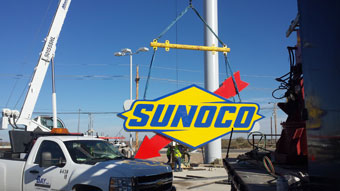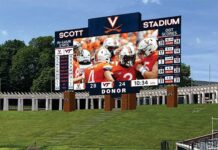The twenty-plus-year relationship between Pro Signs and Sunoco has been fueled by the right solutions and quality sign making—both of which were on display during a recent high-rise signage roll-out at its gas stations.
Pro Signs is a family-owned business that started in 1947. Today President Vincent Protesto runs the company with his two brothers—Jack Protesto, principal, and Ed Protesto, president of the Pro Crane division.
The full-service shop does everything from digital printing to installation to electric signs. It’s this last category that the shop leant its expertise to for Sunoco’s new high-rise program that called for a number of illuminated cabinets on its 120-foot pylon signs, which Pro Signs is continuing to supply through 2016.
“We’re very involved with the development of any new products that Sunoco has. The high-rise program came around, and they wanted to light them with LEDs,” says Vincent Protesto. “We used our supply chain of partners—Pioneer Supply and G2G Lighting—to help us spec out the LEDs and make sure we were staying within Sunoco’s brand and their specifications for the lighting of the back of the face.”
Sunoco wanted to use G2G’s AnPro LED modules, which offer a 155-degree-wide viewing angle that helps spread the light out in the cabinet. The biggest challenge with using these modules, however, was finding the right color temperature.
“There was a particular Kelvin color that was needed. Sunoco wanted a warmer look to go with their colors than what was available in that particular module,” says Michael Sonlin, East Coast sales manager for Pioneer Supply Company, a wholesale distributor that’s been working with Pro Signs since 2000.
G2G got to work and created three warmer Kelvin colors for Sunoco to review. “They were really proactive with helping us get what our client needed,” says Protesto. “They’re a good partner in that way.”
To help in specifying the correct illumination, Pro Signs brought Sunoco into their light lab to show the different lighting options available to achieve the best presentation for their brand. (Note: Pro Signs developed a light laboratory at its facility to help in meeting clients’ expectations for illuminated signs.)

“In the lab, we can show designers and customers how different substrates, backlighting it and frontlighting it, affect the appearance of an illuminated sign,” explains Protesto. “Through the years, we have learned that the specific materials we specify, source, and use can have an effect on the appearance of the client’s brand.
“So we’re educating the client on what’s out there and what they can use.”
According to Protesto, various combinations of vinyl and LEDs can lead to big differences in illumination, so the need for testing in a light lab is important. “You need that ability to dial it in to get it to where the client wants it,”he says.
For this project, Pro Signs also fabricated the Sunoco logo cabinets in thirty-foot-wide and twenty-two-foot-wide sizes. The cabinets are made from two-by-two-inch steel tubing, which is skinned with aluminum.
The shop’s proprietary extrusion system holds the 3M™ Panaflex™ faces in place. “It really works out well tensioning and holding that flex face in the cabinet,” says Protesto.
The faces are decorated with 3M vinyl and a Graphic Protection System (GPS) topcoat.
Once the signs were done, Pro Signs loaded them onto a lowboy trailer to be shipped to the job sites in Texas.
One thirty-foot-wide sign or two twenty-two-foot-wide sign cabinets fit on one trailer. All the signs were shipped with the arrows’ points and tails disconnected, and the thirty-footers were shipped with the cabinet’s top point disconnected as well.
Sunoco’s installers in Texas reassembled and put up the signs, and Pro Signs worked with those installers on the first few jobs to demonstrate how to reattach the point and the pieces of the arrow, roll out and tension the sign face, etc.
“We sent some guys in the beginning to make sure we’re all on the same page,” says Protesto. “But [everything’s] pretty intuitive now.”
Pro Signs helped on the install in another way as well—by figuring out a way to hook up the power supplies at the bottom of the sign. Pro Signs has done something similar on other jobs and thought it would make sense on these signs, as well.
“They did a lot of things to save some time and also to bring down the cost on future service should there be a need to replace the power supplies,” says Sonlin. “If anything’s going to happen with the sign, it’s probably going to happen with the power supply.”
As a final design element, Pro Signs developed a cable wiring harness that allowed for the LED power transformers to be located at the base of the pole, instead of in the sign.
“There are terminal blocks up in the sign that match a diagram of internal blocks that are down with the power supplies,” says Protesto. “When you open the cabinet up, next to every power supply there’s a small LED there. So as soon as you open it up and you see that LED out, you know which power supply is bad.”

Protesto points out this configuration saves the customer in the long run since it enables a worker to handle all the repairs from the ground.
“That’s what’s nice about having the boxes at the bottom—you don’t have to get the heavy equipment out there to change one power supply,” explains Protesto.
Since beginning the rollout of Sunoco’s new signage, Pro Signs has fabricated and supplied about forty signs in the past year, with more to come throughout 2016.
By Ashley Bray
Photos: Pro Signs











